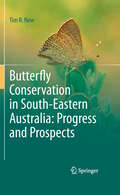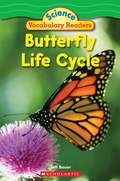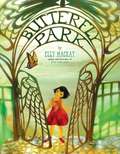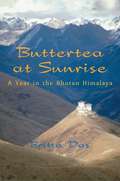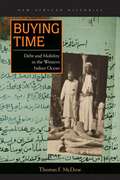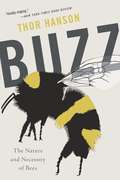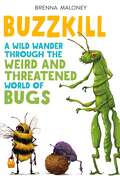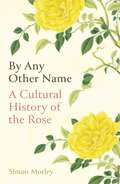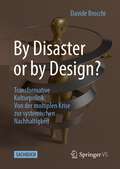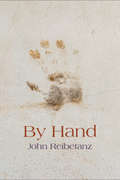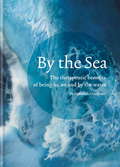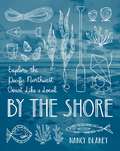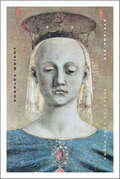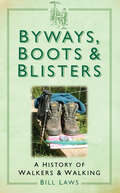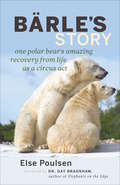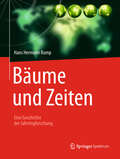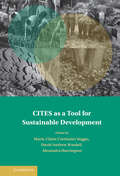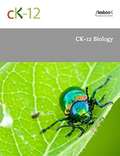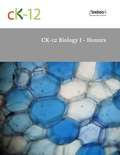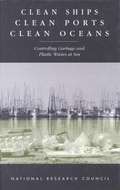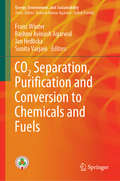- Table View
- List View
Butterfly Conservation in South-Eastern Australia: Progress And Prospects
by Tim R. NewA survey of the development and practice of butterfly conservation in south east Australia, tracing evolution of the science through a series of cases from focus on single subspecies through increasing levels of ecological complexity to critical biotopes and communities. The book summarises much previously scattered information, and provides access to much regional information of considerable interest to practitioners elsewhere.
Butterfly Life Cycle (Science Vocabulary Readers)
by Jeff BauerHave you ever seen a caterpillar? This book will show you how it becomes a beautiful butterfly!
Butterfly Park
by Elly MackayWhen a little girl moves to a new town, she finds a place called Butterfly Park. But when she opens the gate, there are no butterflies.Determined to lure the butterflies in, the girl inspires her entire town to help her. And with their combined efforts, soon the butterflies-and the girl-feel right at home.Elly MacKay's luminous paper-cut illustrations and enchanting story encourage community, friendship, and wonderment in the beauty of everyday life.
Buttertea at Sunrise: A Year in the Bhutan Himalaya
by Britta DasOften seen as a magical paradise at the end of the world, Bhutan is inaccessible to most travellers. Set against the dramatic scenery of the Himalaya, this beguiling memoir recalls hardships and happiness in a land almost untouched by the West. When Britta Das goes to work as a physiotherapist in a remote village hospital, her good intentions are put to the test amid monsoons, fleas, and startling conditions. But as she visits homes in the mountains and learns the mysteries of Tantric Buddhism, the country captivates her very soul. Gaining insights into the traditions of the mystical kingdom, Britta makes friends, falls in love, and battles illness. Throughout it all, as she writes, she worries about the "destructive nearness of technology" and fears that Bhutan’s charm and innocence may soon be lost. Still, Bhutan has endured for centuries, and there is no denying that the country has transformed her life forever.
Buying Time: Debt And Mobility In The Western Indian Ocean (New African Histories)
by Thomas F. McDowIn Buying Time, Thomas F. McDow synthesizes Indian Ocean, Middle Eastern, and East African studies as well as economic and social history to explain how, in the nineteenth century, credit, mobility, and kinship knit together a vast interconnected Indian Ocean region. That vibrant and enormously influential swath extended from the desert fringes of Arabia to Zanzibar and the Swahili coast and on to the Congo River watershed. <p><p> In the half century before European colonization, Africans and Arabs from coasts and hinterlands used newfound sources of credit to seek out opportunities, establish new outposts in distant places, and maintain families in a rapidly changing economy. They used temporizing strategies to escape drought in Oman, join ivory caravans in the African interior, and build new settlements. <p> The key to McDow's analysis is a previously unstudied trove of Arabic business deeds that show complex variations on the financial transactions that underwrote the trade economy across the region. The documents list names, genealogies, statuses, and clan names of a wide variety of people--Africans, Indians, and Arabs; men and women; free and slave--who bought, sold, and mortgaged property. Through unprecedented use of these sources, McDow moves the historical analysis of the Indian Ocean beyond connected port cities to reveal the roles of previously invisible people.
Buzz: The Nature and Necessity of Bees
by Thor HansonFrom the award-winning author of The Triumph of Seeds and Feathers, a natural and cultural history of the buzzing wee beasties that make the world go round.Bees are like oxygen: ubiquitous, essential, and, for the most part, unseen. While we might overlook them, they lie at the heart of relationships that bind the human and natural worlds. In Buzz, the beloved Thor Hanson takes us on a journey that begins 125 million years ago, when a wasp first dared to feed pollen to its young. From honeybees and bumbles to lesser-known diggers, miners, leafcutters, and masons, bees have long been central to our harvests, our mythologies, and our very existence. They've given us sweetness and light, the beauty of flowers, and as much as a third of the foodstuffs we eat. And, alarmingly, they are at risk of disappearing.As informative and enchanting as the waggle dance of a honeybee, Buzz shows us why all bees are wonders to celebrate and protect. Read this book and you'll never overlook them again.
Buzzkill: A Wild Wander Through the Weird and Threatened World of Bugs
by Brenna MaloneyThe praying mantis is the only animal on Earth with one ear—and it’s in the middle of its chest. Aphids are born pregnant. Moths can’t fly during an earthquake. If you didn’t know these things, you soon will. Packed full of jaw-dropping facts, Buzzkill presents the big picture on bugs. You might think ew, gross. Insects are icky. Or scary. Or dangerous. They can be. But there’s so much more you need to know.Insects play a critical role on our planet, from sustenance to pollination to medicines and more. Brenna Maloney tackles both the wacky and weird, as well as threats to insects and their habitats, their possible extinction, and ways that everyday people, like you, can prevent their decline.Find out what all the buzz is about!Godwin BooksA JUNIOR LIBRARY GUILD GOLD STANDARD TITLE
By Any Other Name: A Cultural History of the Rose
by Simon Morley&‘Fascinating...I&’ll never look at a rose in quite the same way again.&’ Adrian Tinniswood The rose is bursting with meaning. Over the centuries it has come to represent love and sensuality, deceit, death and the mystical unknown. Today the rose enjoys unrivalled popularity across the globe, ever present at life&’s seminal moments. Grown in the Middle East two thousand years ago for its pleasing scent and medicinal properties, it has become one of the most adored flowers across cultures, no longer selected by nature, but by us. The rose is well-versed at enchanting human hearts. From Shakespeare&’s sonnets to Bulgaria&’s Rose Valley to the thriving rose trade in Africa and the Far East, via museums, high fashion, Victorian England and Belle Epoque France, we meet an astonishing array of species and hybrids of remarkably different provenance. This is the story of a hardy, thorny flower and how, by beauty and charm, it came to seduce the world.
By Disaster or by Design?: Transformative Kulturpolitik: Von der multiplen Krise zur systemischen Nachhaltigkeit
by Davide BrocchiWir sind inmitten eines radikalen Wandels der Gesellschaft: Wie wird er stattfinden? Wer den Kollaps abwenden will, muss zuerst die Beschaffenheit der „Großen Transformation“ begreifen, die dazu führt. Weil Probleme niemals mit denselben Rezepten gelöst werden können, durch die sie entstanden sind, kann noch „mehr Fortschritt wagen“ keine Antwort sein: Ein Systemwechsel wird dringend benötigt, sprich eine Transformation der Gesellschaft zur Nachhaltigkeit. Einerseits meint Nachhaltigkeit Widerstands- und Anpassungsfähigkeit (Resilienz), andererseits ein „gutes Leben“, das nicht auf Kosten anderer geht – künftige Generationen inbegriffen. Jede große Transformation in der Geschichte der Menschheit wurde bisher von einer kulturellen Revolution ausgelöst. Dieses Buch zeigt, warum dies auch für die zur Nachhaltigkeit gilt. Als DNA der Gesellschaft regelt die Kultur unser Verhältnis zur Umwelt, deshalb setzt die Überwindung der Klimakrise eine kulturelle Evolution voraus. So wie eine ökonomische Monokultur die Krisenanfälligkeit erhöht, ist es die kulturelle Vielfalt als Möglichkeit von Alternativen, die soziale Systeme resilienter macht. Die Transformation zur Nachhaltigkeit benötigt eine Demokratisierung der Demokratie und kann als individueller und kollektiver Lernprozess im Lokalen gestaltet werden, unter anderem durch Reallabore. Was macht eine transformative Kulturpolitik also aus? Im Fokus steht die gesellschaftliche Verantwortung von Medien, Bildung, Wissenschaft und Kunst. Die wichtigste Erkenntnisquelle der Transformation liegt in der Praxis, daher stellt dieses Buch auch praktische Fallbeispiele dar.
By Hand
by John ReibetanzPoems that examine the creative achievements of the human hand, from cave art to contemporary photography. John Reibetanz’s twelfth collection, By Hand, begins with an epigraph from Lewis Mumford: “Until modern times, apart from the esoteric knowledge of the priests, philosophers, and astronomers, the greater part of human thought and imagination flowed through the hands.” Reibetanz’s new poems investigate human creativity as a visceral interaction with the world: our imagining hands finding the music implicit in the stuff of earth, a “duet// of earthbound songsters,” of mind and material, each shaping the other. Centered on this duet, the book encompasses the wide-ranging aspects of our humanity—hands used for good and ill—portrayed in the examined paintings and sculptures, gardens, tapestries, photographs, and carvings. And they explore in particular the relationship in these artifacts between the “givens” of nature and the modifications and contributions of human culture. As Roo Borson says of the collection, “the poems are shot through with moments in which language’s particular dexterity comes into its own and real objects are remade, as when these lines from ‘The Installation’ celebrate the ‘commonality of clay’ in a relief by della Robbia:” the light-quickened humus of the eyes that, for hundreds of years, have read the notes inscribed on the banner an angel is unscrolling…
By the Sea: The therapeutic benefits of being in, on and by the water
by Dr Deborah CracknellIn this stunning book, intuition and instinct meet modern science as the therapeutic benefits of being in, on or by the sea are explained and explored, and how, if we look after the oceans they will, in turn, look after us. There is something about the vastness of the oceans, which are significantly larger than the continents combined, that has drawn humans in a significant way since the beginning of coastal communities. Throughout history, people have gravitated to live near the sea, it is part of the survival instinct. Water also has huge cultural and spiritual significance for people through the ages and for centuries we looked to the sand and surf as a fully-stocked medicine cabinet. Despite the widespread intuitive feeling that being by the water makes us happier and healthier, there hasn't been much scientific evidence to quantify this connection. Until now. Environmental psychology is the study of how the natural environment makes us feel, think and behave, and scientists in this area are discovering the tangible benefits of breathing in the fresh sea air.Reasons to spend time by the sea:1. Just looking at the sea can promote reductions in heart rate and improvements in mood.2. The negative ions in sea air accelerate your ability to absorb oxygen, and balance your seratonin levels.3. The bracing climate is especially beneficial to the respiratory organs and the skin, and also improves circulation and strengthens the body's defences.4. Spending time by the sea promotes better mental health.5. When you are by the sea you are more likely to exercise.
By the Sea: The therapeutic benefits of being in, on and by the water
by Dr Deborah CracknellIn this stunning book, intuition and instinct meet modern science as the therapeutic benefits of being in, on or by the sea are explained and explored, and how, if we look after the oceans they will, in turn, look after us. There is something about the vastness of the oceans, which are significantly larger than the continents combined, that has drawn humans in a significant way since the beginning of coastal communities. Throughout history, people have gravitated to live near the sea, it is part of the survival instinct. Water also has huge cultural and spiritual significance for people through the ages and for centuries we looked to the sand and surf as a fully-stocked medicine cabinet. Despite the widespread intuitive feeling that being by the water makes us happier and healthier, there hasn't been much scientific evidence to quantify this connection. Until now. Environmental psychology is the study of how the natural environment makes us feel, think and behave, and scientists in this area are discovering the tangible benefits of breathing in the fresh sea air.Reasons to spend time by the sea:1. Just looking at the sea can promote reductions in heart rate and improvements in mood.2. The negative ions in sea air accelerate your ability to absorb oxygen, and balance your seratonin levels.3. The bracing climate is especially beneficial to the respiratory organs and the skin, and also improves circulation and strengthens the body's defences.4. Spending time by the sea promotes better mental health.5. When you are by the sea you are more likely to exercise.
By the Shore: Explore the Pacific Northwest Coast Like a Local
by Nancy BlakeyFrom whale watching to squid jigging to making your own sea salt, this adventure guide to the iconic Pacific Northwest coast has something for vacationers and locals alike!Celebrate the wild beauty of the Northwest Coast as you learn how to catch and cook seasonal seafood, including recipes that can be prepared over a driftwood fire, enjoy beach activities for adults and kids, learn the basics of water sports including kayaking and paddleboarding, and get ideas for outdoor adventure opportunities and travel itineraries from paddle camping to beach hikes to road trips. Also includes wildlife ID guides and seasonal natural events like meteor showers and the solstice and oceanside festivals. The book covers the coastal areas of Oregon (from Astoria to Florence); Washington (including Puget Sound and the Olympic Peninsula); and British Columbia, Canada (including Vancouver Island). Gorgeously illustrated with line drawings and color photographs, this book is a visual treat for the armchair adventurer, as well as a practical guide to take with you on your next outing.
Bye-and-Bye: Selected Late Poems
by Charles WrightThe acclaimed collection by the Pulitzer Prize–winning poet whose work is “conceived in a manner that never ceased to astonish” (Helen Vendler, The New Republic).Over the course of nineteen collections of poems, former US Poet Laureate Charles Wright has built “one of the truly distinctive bodies of poetry created in the second half of the twentieth century” (David Young, Contemporary Poets).Bye-and-Bye, which brings together selections from Wright’s more recent volumes—including the entirety of Littlefoot, Wright’s moving, book-length meditation on mortality—showcases the themes and images that have defined his mature work: the true affinity between writer and subject, human and nature; the tenuous relationship between description and actuality; and the search for a truth that transcends change and death.Winner of the 2013 Bollingen Prize,. Bye-and-Bye is a wonderful introduction to the poetic vision of one of America’s finest and best-loved poets.
Byways, Boots and Blisters: A History of Walkers and Walking
by Bill Laws'The great affair is to move: to come down off this feather-bed of civilisation, and find the globe granite underfoot,' wrote Robert Louis Stevenson. This book celebrates the history of walking for leisure and pleasure. There's no shortage of the famous, and the not so famous, exponents of a good, long walk: Dr Johnson and his faithful Boswell on their Hebridean jaunt; John Taylor, whose Penniless Pilgrimage, a record of his 1618 journey from London to Edinburgh, provided the first account of a walking tour; and Samuel Coleridge who conceived his epic tale of the Ancient Mariner on a ramble through Devon. The author also includes the stories of key inventions: the cagoule, the Thermos flask, the rucksack, Gore-Tex and the walking pole. Fully illustrated throughout, Byways, Boots and Blisters tells the engaging history of one of man's favourite pastimes.
Bärle's Story: One Polar Bear's Amazing Recovery from Life as a Circus Act
by Else PoulsenThe award-winning zookeeper and author of Smiling Bears shares her account of rescuing and rehabilitating a bear held in a Caribbean circus. When a nineteen-year-old female polar bear named Barle is rescued from the inhumane conditions of a circus in the Caribbean and flown to safety in Detroit, zookeeper Else Poulsen—renowned throughout the world for her work rehabilitating abused bears—is on hand to meet her and help her on the road to recovery and self-discovery. Thus begins Barle&’s gradual introduction into the world of polar bears. Slowly she forges relationships with the other bears in the zoo and eventually mates with a young male and successfully raises a cub. By living in a caring, enriched environment focused on her welfare, Barle is able to recover from the trauma she had suffered at the circus and develop skills that are important to thriving as a polar bear. As Poulsen documents, however, not all captive bears are so fortunate. Augmented with black-and-white photographs, Barle&’s Story provides a rich and moving portrayal of a remarkable bear and of the author&’s inspiring work to help her discover her true polar bear ways.Praise for Barle&’s Story &“This intelligent, stark, and gently humorous book makes one think that if all animals were listened to in the way that…Poulsen listens to bears, our children would inherit an infinitely kinder and safer world that the one they enjoy now.&” —Dr. Jill Robinson MBE, founder and CEO, Animals Asia Foundation &“At once deeply heart-wrenching, heart-warming, and heartful. Read this wonderful book and share it widely.&” —Dr. Marc Bekoff, author of Why Dogs Hump and Bees Get Depressed
Bäume und Zeiten – Eine Geschichte der Jahrringforschung
by Hans Hermann RumpAnhand der Jahresringe von Bäumen können kultur- und naturhistorische Ereignisse datiert und eingeordnet werden. Wie diese Methode entwickelt wurde und wie sie noch heute eingesetzt wird, beschreibt dieses Buch eindrucksvoll. Es bietet einen Einblick in Konzepte und Arbeitsmethoden von Naturforschern bei ihrer Suche nach verlässlichen Chronologien von der frühen Neuzeit bis heute. Fehler und methodische Irrwege als systembedingte Begleiter langwieriger und komplexer Forschungsprozesse blieben dabei nicht aus. Deshalb wird die Dynamik des „Gewordenen“ und nicht die Statik des „Gewesenen“ in den Mittelpunkt der Betrachtung gestellt. Die thematisch breit gefächerte und interdisziplinär konzipierte Darstellung spricht nicht nur Vertreter der Life Sciences und der historischen Wissenschaften an. Auch für einen weiteren Leserkreis ist die Entwicklung einer Forschungsmethode von Interesse, die im aktuellen Diskurs um die Veränderung des globalen Klimas eine wichtige Rolle spielt.
Bürgerbeteiligung als Finanzierungsinstrument für (neue) Geschäftsfelder kommunaler Stadtwerke in der Energiewende: Eine Anwendung des New Public Management- und New Public Governance-Ansatzes
by Jennifer KowallikDas Ziel dieses Buches ist es, einen theoriebezogenen Beitrag dazu zu leisten, kommunale Stadtwerke und finanzielle Bürgerbeteiligung als Bestandteil der NPG-Entwicklung zu erforschen. In diesem Zusammenhang wurde analysiert, welche Formen von finanzieller Bürgerbeteiligung es für die Beschaffung von Eigen-, Mezzanine- und Fremd-Kapital für ein kommunales Stadtwerk gibt und welche Formen davon primär umgesetzt werden. Die zentralen Fragen dabei, welche Effizienz- und Effektivitätskriterien von öffentlichen kommunalen Stadtwerken in Abhängigkeit ihrer Unternehmenszieldefinition und -dominanz für die Auswahl eines Finanzierungsinstrumentes generell und im Speziellen bei einer finanziellen Bürgerbeteiligung herangezogen werden, konnten beantwortet werden. Es wird aufgezeigt, warum eine ggf. ineffiziente finanzielle Bürgerbeteiligung trotzdem ein effektives Finanzierungsinstrument zur Erfüllung öffentlicher Energieversorgungsaufgaben (im Rahmen der Energiewende) im Sinne der Daseinsvorsorge sein kann.
CABIN: Off the Grid Adventures with a Clueless Craftsman
by Patrick HutchisonTHE NATIONAL BESTSELLERA memoir of the author's journey from an office job to restoring a cabin in the Pacific Northwest, based on his wildly popular Outside Magazine piece.Wit’s End isn’t just a state of mind. It’s the name of a gravel road, the address of a run-down off-the-grid cabin, 120 shabby square feet of fixer-upper Patrick Hutchison purchased on a whim in the mossy woods of the Cascade Mountains in Washington state.To say Hutchison didn’t know what he was getting into is no more an exaggeration than to say he’s a man with nearly zero carpentry skills. Well, used to be. You can learn a lot over six years of renovations. CABIN is the story of those renovations, but it's also a love story; of a place, of possibilities, and of the process of construction, of seeing what could be instead of what is. It is a book for those who know what it’s like to bite off more than you can chew, or who desperately wish to.
CITES as a Tool for Sustainable Development (Treaty Implementation for Sustainable Development)
by Alexandra Harrington Segger, Marie-Claire Cordonier David Andrew WardellSaving endangered species presents a critical and increasingly pressing challenge for conservation and sustainability movements, and is also matter of survival and livelihoods for the world's poorest and vulnerable communities. In 1973, a global Convention on International Trade in Endangered Species (CITES) was adopted to stem the extinction of many species. In 2015, as part of the Sustainable Development Goals (SDG 15) the United Nations called for urgent action to protect endangered species and their natural habitats. This volume focuses on the legal implementation of CITES to achieve the global SDGs. Activating interdisciplinary analysis and case studies across jurisdictions, the contributors analyse the potential for CITES to promote more sustainable development, proposing international and national regulatory innovations for implementing CITES. They consider recent innovations and key intervention points along flora and fauna value chains, advancing coherent recommendations to strengthen CITES implementation, including through the regulation of trade in endangered species globally and locally.
CK-12 Biology I (with image descriptions)
by Ck-12 FoundationOpen source biology textbook from CK-12.
CK-12 Biology I - Honors
by Ck-12 FoundationCK-12 Foundation's Biology 1- Honors FlexBook Covers the following chapters:<P><P> Foundations of Life Science- scientific investigations, methods, observations, & communication.<P> Chemical Basis of Life- matter, the significance of carbon, lipids, proteins.<P> Cell Structure and Function- prokaryotic, eukaryotic, plant, & animal cell features; structures / functions of DNA, RNA, protein, cell transport, homeostasis.<P> Photosynthesis- water, carbon, and nitrogen cycle between abiotic and biotic resources.<P> Cellular Respiration- relation to glycolysis, Krebs Cycle, electron transport chain.<P> Cell Division and Reproduction- cell division, reproduction.<P> Mendelian Genetics- inheritance, sex-linked traits.<P> Molecular Genetics- DNA, RNA, protein synthesis, mutation, regulating gene expression.<P> Human Genetics- human genome, diseases, Biotechnology- DNA technology, gene cloning.<P> History of Life- evolution, macroevolution, extinctions, episodic speciation, response to change.<P> Evolutionary Theory- Darwin's Theory of Evolution, common ancestry and natural selection.<P> Evolution in Populations- genetics of populations, genetic diseases, natural selection.<P> Classification- Taxonomy, scientific classification of organisms.<P> Principles of Ecology- Ecology's relation with energy; ecosystems, the water, carbon, and nitrogen cycles.<P> Biomes, Ecosystems and Communities- terrestrial/ aquatic biomes, community interactions.<P> Populations- Analysis of populations and dynamics.<P> Ecology and Human Actions- Balance between humans and the earth addressing natural resources, ecosystems, & biodiversity.<P> The Human Body- systems.<P> Nervous and Endocrine Systems- structures & functions, homeostasis.<P> Skeletal, Muscular, and Integumentary Systems- structures, functions, & homeostasis.<P> Circulatory and Respiratory Systems- structures and functions.<P> Digestive and Excretory Systems- structures/ functions, food pyramid.<P> Immune System and Disease- Body defenses against pathogens.<P> Reproductive System and Human Development- human reproductive systems, reproductive lifecycle, STDs.
CLEAN SHIPS CLEAN PORTS CLEAN OCEANS: Controlling Garbage and Plastic Wastes at Sea
by Committee on Shipborne WastesMarine debris is a serious environmental problem. To do its part, the United States has agreed to abide by the international treaty for garbage control at sea, known as MARPOL 73/78 Annex V.Clean Ships, Clean Ports, Clean Oceans explores the challenge of translating Annex V into workable laws and regulations for all kinds of ships and boats, from cruise ships to fishing crafts and recreational boats. The volume examines how existing resources can be leveraged into a comprehensive strategy for compliance, including integrated waste management systems and effective enforcement.Clean Ships, Clean Ports, Clean Oceans describes both progress toward and obstacles to Annex V compliance. The book covers How shipborne garbage orignates and what happens to garbage discharged into the seas.Effects of discharge on human health, wildlife safety, and aesthetics.Differences in perspective among military, industrial, and recreational seafarers and shoreside facilities. Clean Ships, Clean Ports, Clean Oceans will be important to marine policymakers, port administrators, ship operations officers, maritime engineers, and marine ecologists.
CO2 Separation, Purification and Conversion to Chemicals and Fuels
by Franz Winter Rashmi Avinash Agarwal Jan Hrdlicka Sunita VarjaniThis book presents the recent research on the separation, purification and downstream utilization of CO2 and other flue gases. Chapters include a detailed discussion on the purification and further conversion of CO2 to commodity chemicals and fuels. With contributions from renowned researchers in the field, the book focuses on the current challenges of catalytic high-pressure chemical conversion and biochemical conversion into high-value products. This book is of interest to researchers, professionals, and students working on carbon capture and sequestration, and is a valuable resource for policy makers and government agents working on guidelines and frameworks for carbon capture and reuse.
